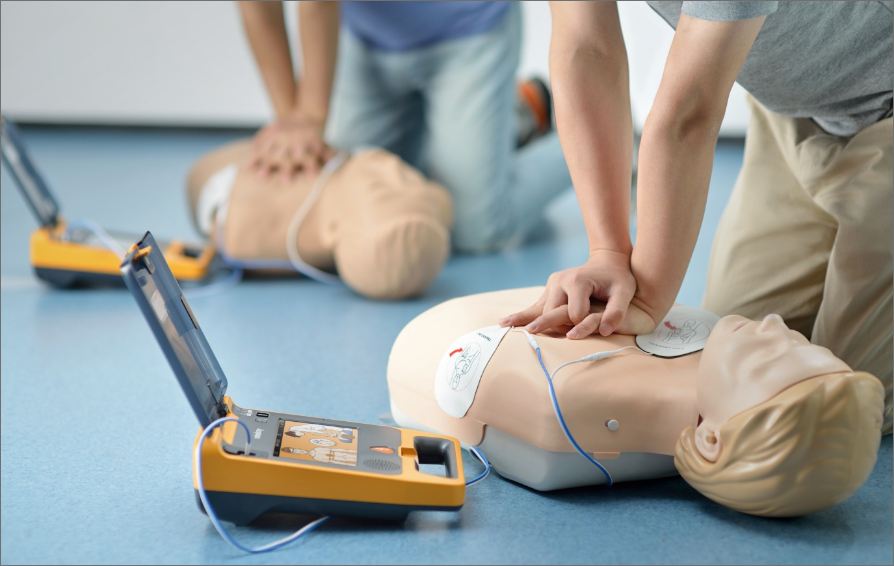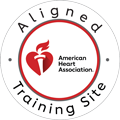Workplace safety is a top priority for every responsible organization. From fire drills to ergonomic chairs, companies invest in a wide array of systems to protect their employees. But one of the most vital — and often overlooked — aspects of workplace safety is preparedness for medical emergencies, particularly sudden cardiac arrest (SCA). According to the Occupational Safety and Health Administration (OSHA), approximately 10,000 cardiac arrests occur in the workplace every year in the United States. Immediate intervention with an Automated External Defibrillator (AED) can mean the difference between life and death.

What are AEDs in the Workplace?
As more businesses recognize the importance of emergency preparedness, AEDs are becoming an essential component of workplace safety programs. They offer a fast, effective response in a life-threatening crisis. This article explores what AEDs are, how they work, the rules surrounding their use, and, most importantly, the top five benefits of installing AEDs in the workplace.
How AEDs Function in Emergencies
AEDs, or Automated External Defibrillators, are portable medical devices designed to analyze heart rhythms and deliver an electric shock to restore a normal heartbeat in cases of sudden cardiac arrest. Unlike manual defibrillators used in hospitals, AEDs are automated and user-friendly, requiring minimal training. They guide users through each step with voice prompts, making them suitable for office environments, construction sites, schools, and virtually any workplace.
Types of AEDs in Workplace Settings
There are different types of AEDs available, including fully automatic and semi-automatic models. Both types can be integrated into existing emergency protocols and are most effective when placed in easily accessible locations. AEDs work best when part of a broader safety plan that includes CPR training, emergency drills, and clear communication systems.
What is the Purpose of an AED?
The primary purpose of an AED is to treat sudden cardiac arrest, which occurs when the heart’s electrical system malfunctions, causing it to stop beating effectively. AEDs analyze the heart’s rhythm and, if necessary, deliver a defibrillating shock to reset the heart. This action is a key part of the “chain of survival,” a sequence of critical steps that includes early recognition, prompt CPR, rapid defibrillation, and advanced medical care. Time is of the essence in cardiac emergencies — for every minute without defibrillation, survival chances drop by 7 to 10 percent. Unlike manual defibrillators that require a healthcare provider’s expertise, AEDs are designed for immediate use by trained bystanders, making them ideal for non-clinical settings.
What are the Rules for Using an AED?
There are specific rules and guidelines for using AEDs in the workplace. Legal requirements can vary by state, but many areas mandate that certain types of businesses provide AEDs and employee training. OSHA strongly encourages AED programs in workplaces and provides guidelines for implementation. Training typically involves CPR certification with AED instruction, often completed in just a few hours. Maintenance is also critical. AEDs require regular inspections to ensure that batteries and pads are functional and up to date. Documentation protocols, including usage logs and incident reports, help maintain compliance. Importantly, Good Samaritan laws protect employees who use AEDs in good faith, reducing legal concerns.
Call Us Now
Get the Best CPR Class in Indianapolis Today!
Now let’s explore the top five benefits of AEDs in the workplace and why they’re a smart investment for any organization.
Top 5 Benefits of AEDs in the Workplace
Save Lives Through Rapid Response
The most compelling benefit of having AEDs in the workplace is their ability to save lives through rapid response. Studies show that when an AED is used within the first three minutes of cardiac arrest, survival rates can soar above 70 percent. In contrast, waiting for emergency medical services often takes too long. Numerous real-world stories highlight how quick AED use by coworkers has led to full recoveries. This life-saving potential underscores the value of immediate access to AEDs.
Reduced Liability and Legal Protection
Beyond saving lives, AED programs can also reduce liability and provide legal protection. Employers who implement AED programs demonstrate a proactive commitment to employee welfare. In doing so, they reduce the risk of lawsuits tied to inadequate emergency preparedness. Many insurance providers recognize this and may offer incentives or reduced premiums for businesses with AEDs and trained staff. Compliance with OSHA recommendations also reinforces legal safety and can be a critical component in workplace audits.
Enhanced Employee Confidence and Morale
AEDs can also enhance employee confidence and morale. Knowing that life-saving equipment is available boosts overall workplace security and shows that leadership genuinely values staff wellbeing. This sense of care can positively affect workplace culture, increasing job satisfaction and even employee retention. In emergencies, coworkers often become first responders. When they know they are equipped and prepared, their confidence and composure can make all the difference.
Cost-Effective Safety Investment
While AEDs require an upfront investment, they are cost-effective in the long run. The cost of purchasing and maintaining an AED is small compared to the potential expenses of a wrongful death lawsuit or workers’ compensation claim. Furthermore, companies that invest in comprehensive safety measures may benefit from lower insurance costs. When viewed through the lens of risk management and return on investment, AEDs are a sound financial decision that also supports employee health.
Improved Emergency Response Capabilities
Finally, AEDs significantly improve emergency response capabilities. In a cardiac emergency, even a few seconds can be critical. AEDs allow businesses to respond instantly, bridging the gap until professional medical help arrives. When combined with CPR training and other first aid measures, AEDs help create a comprehensive emergency preparedness plan. They also integrate seamlessly with fire drills and other safety systems, ensuring a holistic approach to workplace readiness.
Implementation Considerations
For businesses considering AED implementation, several practical considerations come into play. Choosing the right AED model is important — some workplaces may benefit from rugged devices suited for industrial environments, while others need compact, wall-mounted units for office settings. Placement should prioritize visibility and accessibility, such as near break rooms or elevators. Employee training is essential, and refresher courses should be conducted regularly. Ongoing maintenance ensures that devices are always ready when needed.
Training and Certification
Proper training and certification play a vital role in the success of any AED program. CPR and AED certification courses teach employees how to respond quickly and effectively during cardiac emergencies. These classes are often hands-on, helping participants build real-world confidence. Refresher training every one to two years ensures that skills remain sharp and that new staff are adequately prepared. Building a team of trained responders within the organization enhances overall readiness and resilience.
About CPR Indianapolis
CPR Indianapolis is a trusted provider of American Heart Association-certified training, offering initial and renewal courses in BLS for Healthcare Providers, ACLS, PALS, and CPR with AED and First Aid. Known for stress-free, hands-on learning, CPR Indianapolis helps businesses prepare their teams to handle emergencies with skill and confidence. Their expert instructors ensure participants leave each class ready to take action, ultimately making the workplace safer for everyone.
AEDs in the workplace are more than a safety feature — they’re a life-saving tool that protects employees, reduces liability, and promotes a culture of care. From immediate cardiac response to long-term legal and financial benefits, AEDs offer clear advantages for organizations of all sizes. If your workplace hasn’t implemented an AED program, now is the time to act. Partner with trusted providers like CPR Indianapolis to ensure your team is trained, your equipment is reliable, and your workplace is prepared for anything.


